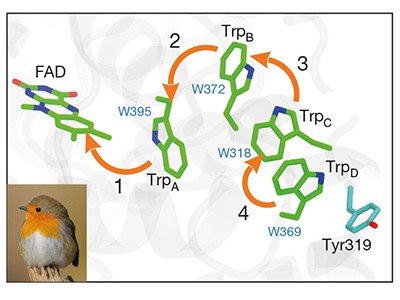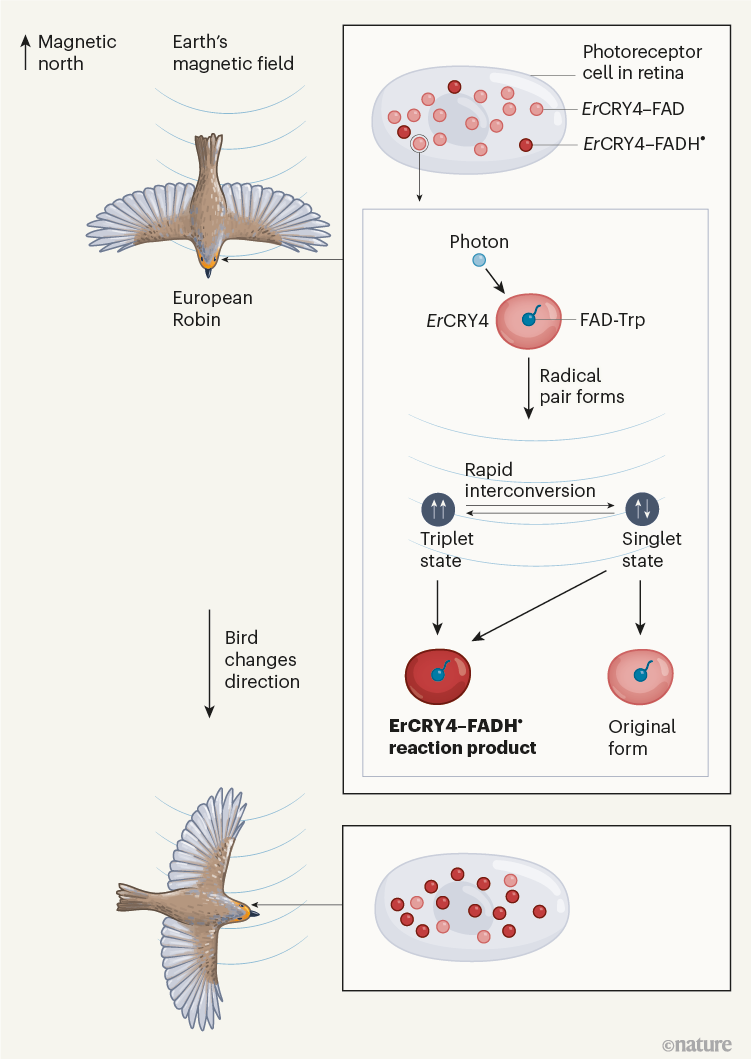Arguably the greatest mystery in sensory biology is magnetoreception — how animals sense Earth’s magnetic field and use it as a compass to determine their spatial orientation. Animals as varied as birds, sea turtles, fishes, crustaceans and insects depend on this field for both short- and long-range navigation1. The identity of the biological tissue responsible for sensing the field’s direction, and the sensory mechanism that underpins this type of navigation, have remained an enigma. In migratory birds, the main contenders are magnetically sensitive proteins called cryptochromes, which are located in the retina2. However, proof has been lacking that these proteins truly possess the magnetic sensitivity and physical properties needed to detect Earth’s extremely weak magnetic field. Writing in Nature, Xu et al.3 provide this proof in vitro, bringing us tantalizingly close to solving the mystery of magnetoreception.
There are currently two main hypotheses for how animals sense Earth’s magnetic field1,4 (as well as some alternative hypotheses put forward in the past few years5,6). One proposes that, as an animal changes direction, crystals of the oxidized-iron compound magnetite (Fe3O4), located in its body and aligned with the field, exert a rotational force — called torque — on mechanoreceptors with which they are in physical contact. This might thereby signal changes in body alignment through the opening and closing of mechanoreceptor ion channels.
The other main hypothesis (Fig. 1) proposes that, when cryptochrome proteins absorb photons of light and become ‘photoexcited’, they form magnetically sensitive chemical intermediates known as radical pairs. Variations in the yield of their reaction product (the form of the cryptochrome that contains a radical molecule called FADH•) are thought to signal the animal’s direction with respect to Earth’s magnetic field7,8. These two proposed mechanisms are not mutually exclusive6 — indeed, migratory birds might possess both, using magnetite for their ‘magnetic-map’ sense (the ability to sense magnetic characteristics associated with a given location on Earth’s surface) and cryptochromes for their magnetic-compass sense (which offers the animal a way to sense its direction relative to magnetic north)1,2.
Cryptochromes are found both in animals and in plants, and are a type of protein known as a flavoprotein. Cryptochromes bind non-covalently to a molecule called a chromophore, such as FAD, which absorbs photons of blue light when in its fully oxidized state. In animals, cryptochrome proteins termed CRY1 and CRY2 are involved in the regulation of daily (circadian) rhythms9, and their expression levels in tissue typically cycle over the course of 24 hours. By contrast, the cryptochrome CRY4 lacks such signs of circadian cycling, suggesting that it has a different biological role, possibly that of magnetoreception10,11. CRY4 is found only in birds, fishes and amphibians, which are types of animal with well-documented magnetically guided behaviours. CRY4 has therefore emerged as the leading candidate for enabling cryptochrome-based magnetoreception in vertebrates.
Previous analysis10 of chickens (Gallus gallus) and migratory European robins (Erithacus rubecula) indicates that CRY4 is located in the outer segments of two types of photoreceptor cell in the retina — double cones and long-wavelength single cones. This is an ideal location for receiving the light that would excite cryptochromes and thus aid magnetic sensing. Further evidence consistent with a possible role for CRY4 in magnetoreception is that its expression level in the robin retina rises as the migratory season approaches, whereas its level remains permanently low in non-migratory chickens10.
Xu and colleagues’ major advance is the demonstration that the version of CRY4 (dubbed ErCRY4) in the migratory European robin has a crucial property needed to sense Earth’s magnetic field: the ability to form radical pairs that have high magnetic sensitivity. Radical pairs arise when the FAD bound to ErCRY4 is reduced (gains an electron) in the presence of light. Radicals contain an odd number of electrons, and a radical pair consists of two radicals that have been created simultaneously, usually by a chemical reaction. In ErCRY4, the radicals’ odd electrons are supplied through sequential electron-hopping along a chain of three or four tryptophan amino-acid residues (termed TrpA to TrpD) that are located between FAD and the surface of the cryptochrome.
In the case of FAD, the odd electron that arises from reduction in the presence of light makes the radicals intrinsically magnetic. This is because electrons behave as microscopic magnets, with a property that physicists call spin (typically symbolized by an arrow ↑). In a molecule with an even number of electrons, the spins of each electron pair exactly cancel each other out, rendering the molecule non-magnetic.
If the spins of the odd electrons in each of the two radicals in a radical pair are antiparallel (↓↑), the radical pair is said to occupy a singlet state, but when they are parallel (↑↑), the pair occupies a triplet state. When cryptochrome becomes photoexcited, it always forms a radical pair in the singlet state, but it doesn’t stay that way for long. Owing to a quirk of quantum mechanics, the radical pair rapidly converts to the triplet state, and then continues to bounce between these two states millions of times per second. Each of these two states can produce a reaction product — the form of CRY4 that contains the radical FADH•, which is the proposed signalling molecule for magnetoreception (Fig. 1). But the singlet state can also revert to its oxidized, non-excited ground state, thereby reducing its relative contribution to the generation of reaction products. Thus, if the interconversion of the singlet and triplet states can be manipulated to change the relative amounts of time spent in each of the two states, so too can the yield of the reaction products be manipulated, because a greater fraction of time in the triplet state leads to a higher yield of reaction products.
Herein lies the heart of the proposed cryptochrome-based magnetosensor: the relative amounts of time spent in the singlet and triplet states and the yield of reaction products are directly manipulated by the direction of Earth’s magnetic field. The interaction between a single ErCRY4 molecule and the field is, on its own, at least one million times too weak to create the radicals and influence their stability2, but the energy required is provided by the photon absorbed by FAD. However, for this to work at all, the radical pair must be sufficiently magnetically sensitive, and the reaction product must exist for long enough and have a sufficiently high yield to realistically act as a sensory signalling substance. In a tour de force of biophysical chemistry, Xu and colleagues used a wide range of techniques, such as spectroscopic methods and molecular-dynamics simulations, to show that all of these conditions are satisfied by ErCRY4, at least in vitro.
Not only does ErCRY4 have a much higher magnetic sensitivity than do CRY4 proteins in non-migratory pigeons and chickens, but site-specific mutations of amino-acid residues in ErCRY4 also reveal that its TrpD is probably responsible for generating high and long-lasting (of greater-than-millisecond duration) yields of reaction products that would be needed for magnetosensory signalling. Although the evidence provided by Xu and colleagues is not definitive proof that ErCRY4 is the elusive magnetoreceptor in vivo, the authors have brought us ever closer to solving this abiding mystery of sensory biology.
"bird" - Google News
June 23, 2021 at 10:03PM
https://ift.tt/3A1Kha2
Unravelling the enigma of bird magnetoreception - Nature.com
"bird" - Google News
https://ift.tt/2s1zYEq
https://ift.tt/3dbExxU
Bagikan Berita Ini



















0 Response to "Unravelling the enigma of bird magnetoreception - Nature.com"
Post a Comment